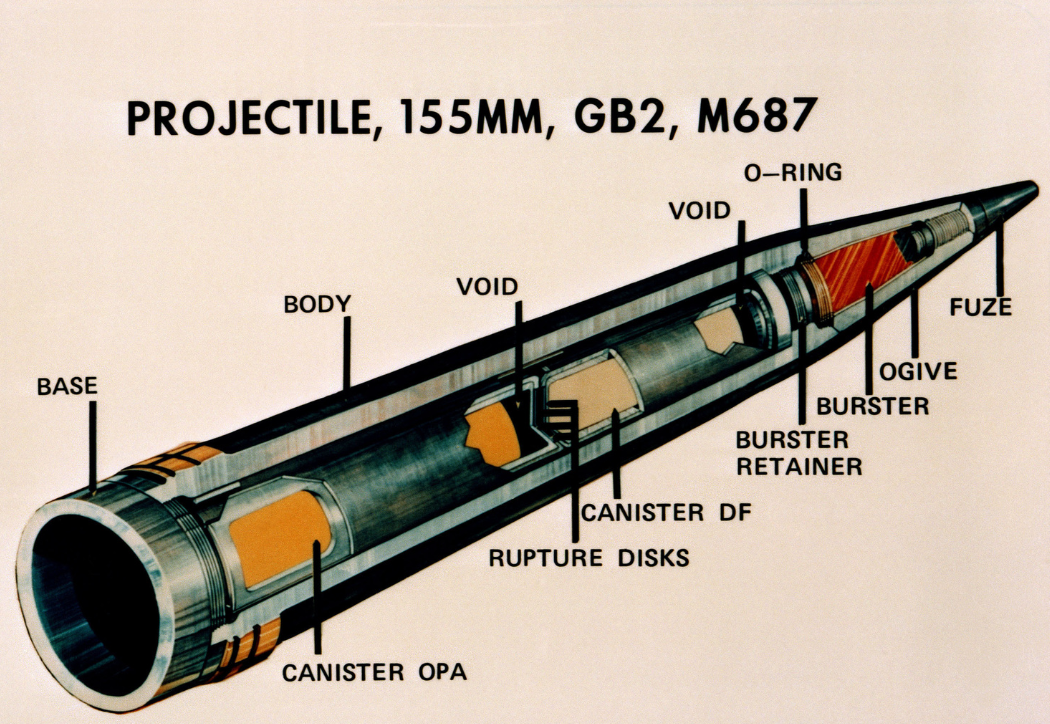Binary Agents
In chemical warfare, a binary
weapon is defined as a CW agent where the agent is produced during
the flying time of the ammunition (rocket, missile, shell, or
grenade) towards the target. The claimed purpose of this kind of CW
agent is to reduce the risks in the production, storage, transport,
and even destruction of the toxic agent. This is possible because
the starting materials are relatively non-toxic precursors. For this
task to be feasible the reaction has to be controlled to avoid
overheating or explosion during the flight. Also, it should
preferably run without solvent and has to be completed, with a high
yield, in a matter of seconds. Usually the body of a binary
projectile contains two separate canisters, one behind the other,
each containing one starting material. The force of launching causes
the breaking of the canisters, which mixes the starting materials
and triggers the reaction to produce the chemical agent, alternative
mechanisms have been developed.
The idea of designing this kind of ammunition originates from World
War II , when military chemists developed, but never used, a binary
bomb to deliver the blood agent arsine. The vesicant
N-(2-chloroethyl)-N-nitrosocarbamate [C5H8Cl2N2O3]
was also considered as a potential binary weapon in the 1940s, but
never fully developed. The first nerve agents developed as binary
weapons were GB-2, GD-2, and VX-2, the binary versions of sarin,
soman, and VX, respectively. They were all developed by the USA
during the Cold War they have been called the third
generation of CW agents.
The first weapon designed to use binary agents was the American BL80
"Bigeye", an air dropped 500lb bomb. Bigeye produced VX from QL and
sulfur - see VX2 below. It was originally designed in the 1960s and
production ended in 1990.
In the open literature little is known about agents developed in the
Soviet Union. They are thought to be five to ten times more toxic
than VX The toxicity of these binary agents does not rely
primarily on the inhibition of acetylcholinesterase,
but it is thought that it causes permanent neuropathy. Consequently,
conventional nerve agent antidotes (atropine
sulfate and pralidoxime
chloride) may not work. Reactive oximes such as potassium
2,3-butanedione monoximate may be use in detoxification.
Known binary agents include the following:
GB-2: (binary sarin, GB-2)
There are several reported precursors for GB-2. The most frequently reported is the reaction of methylphosphonic difluoride (DF) [CH3F2OP] located in 1 canister, while a mixture of isopropyl alcohol [CH3CHOHCH3] and isopropylamine [(CH3)2CHNH2]solution (OPA) is in the second canister. The isopropyl amine binds to the hydrogen fluoride generated during the chemical reaction. After deployment of the weapon, the 2 canisters rupture and the chemical mixture produces sarin.
GD-2 binary (binary soman, GD2):
methylphosphonic difluoride (DF) [CH3F2OP] is located in 1 canister, while a mixture of pinacolyl alcohol [C6H14O] and an amine [R-NH2]is in a second canister. After deployment of the weapon, the 2 canisters rupture and the chemical mixture produces GD.
VX2 binary (VX2):
Isopropyl aminoethylmethyl phosphonite (QL) [C11H26NO2P] is in 1 canister. The other canister contains elemental sulfur[S]. When the weapon is fired, the canisters rupture and the chemical mixture produces VX.
Novichok agents:
Not all novichok agents are binary, but binary versions have been made of most of them.Substance 33:
Possibly produced from the reaction between 2-methylpropyl methylphosphonocyanidate (PCN) [C5H12FO2P] and 2-(diethylamino)ethanethiol [C6H16ClNS] (DEAT)
A-232:
Possibly produced from the reaction between methyl phosphorocyanidofluoridate [CH3F2O2P] (PCF) and N,N-diethyl-2-iminopropan-1-amine [C7H16N2] (NNDA).
A-234 (Novichok 7)
Details unknown.
In the open literature little is
known about agents developed in the Soviet Union. They are thought
to be five to ten times more toxic than VX The toxicity of
these binary agents does not rely primarily on the inhibition of acetylcholinesterase,
but it is thought that it causes permanent neuropathy. Consequently,
conventional nerve agent antidotes (atropine
sulfate and pralidoxime
chloride) may not work. Reactive oximes such as potassium
2,3-butanedione monoximate may be use in detoxification.
Other countries believed to have developed binary agents include
Syria, Iraq and North and South Korea.

